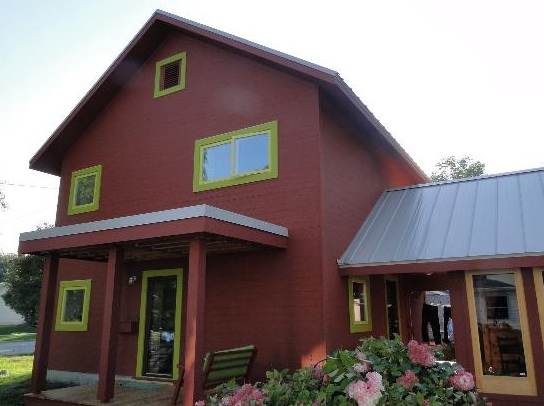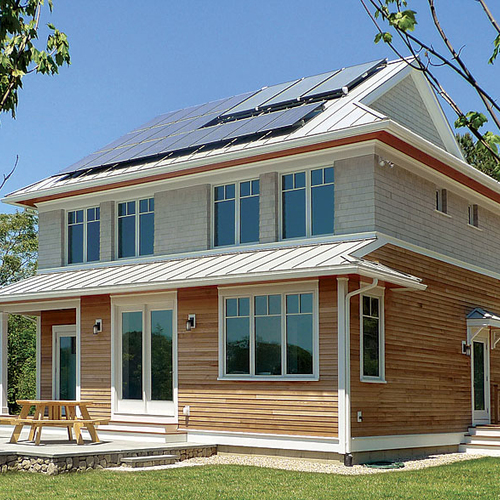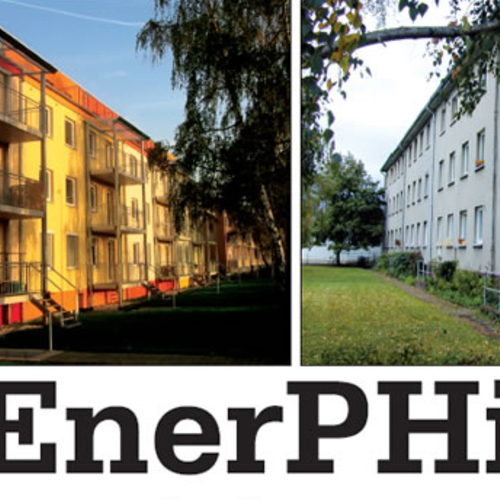Image Credit: Sonya Newenhouse, Madison Environmental Group
Image Credit: Sonya Newenhouse, Madison Environmental Group Newenhouse’s Passivhaus prototype includes three bedrooms and two baths in 968 sq. ft. of interior space.
Sonya Newenhouse’s home — a 968-sq.-ft. three-bedroom in Viroqua, Wisconsin, that she shares with her sister, Astrid, and their roommate, Bjorn — is a source of both comfort and marketing potential. Comfort because the house, which was certified to the Passivhaus standard in early November, is handling the onset of winter without a hitch. Marketing potential because the house also is the model for what Newenhouse is pitching as a “kit home” package of plans, materials, and consulting services that will help her clients build homes of like size and performance.
Newenhouse is president of Madison Environmental Group, a green building and sustainability consultancy that has developed designs and construction documents for homes of 600, 800, and 1,000 sq. ft. (in one-, two-, and three-bedroom configurations, respectively) that would meet Passivhaus requirements for airtightness, heating, and primary energy use, and also would qualify for LEED for Homes Platinum certification. As noted on an MEG summary of the prototype project, the kit-home package also includes special building materials, a detailed specification sheet for the remaining building materials, project management assistance, and green construction consulting for clients as they progress through the building process.
Why Passivhaus?
In a blog posted shortly after the prototype home was certified by Passivhaus Institut, Newenhouse writes that one reason Passivhaus is the centerpiece of her kit-home strategy is that it addresses what she sees as an ecological imperative in new-home construction. “If we’re going to take responsibility for reducing our energy footprint and prepare for the future,” she says, “it’s critical to leapfrog our building efficiency standards. No longer is 25% or 50% more efficient good enough — 80% to 90% more energy efficient is what’s needed.”
The NewenHouse, as the prototype has come to be known, joins the Passive House in the Woods, in Hudson, which was supervised by architect Tim Eian, who also has been guiding a couple in Minneapolis on a retrofit of their three-bedroom house to Passivhaus Institut’s EnerPHit standard.
The prototype’s slab and exterior walls are insulated to R-57, the roof to R-100. Dense-packed cellulose fills the rafter bays and the 16-in.-thick double-stud walls. The building is designed to accommodate both solar hot water and photovoltaic systems. Newenhouse estimates that the total annual electric demand for the house, with its three occupants, is 6,119 kWh.
Newenhouse arranges tours of the house by appointment, and also will play host to an open house from 4:00 to 6:00 p.m. on December 23.
Weekly Newsletter
Get building science and energy efficiency advice, plus special offers, in your inbox.
















One Comment
Interesting design, with a few "issues"
To preface my comments I have not had a chance to review all the videos and articles on their blog. I am sure many of my concerns have been addressed. I like many of the design features shown. The layout works, and uses as much of the space as possible. The built-in storage is well thought out, leaving little wasted room. And most importantly this is not another one of those 3000+ square foot “green” homes! The extensive use of salvage material is certainly a bonus.
However there are others items that could use some improvement. As anyone who has lived in a house with tight 180 degree turns on the stairways could tell you they are a major pain. You cannot move mattresses or other large/medium size pieces of furniture without risking your safety (and sanity). In fact for many items it would be impossible! Hopefully those windows are fully operable as they may be the only option. The bathroom on the second floor has several issues. First I wish the tub would have been built into a platform, as there are nearly impossible to clean corners of the room. Secondly the pocket door built into the wall between the bathroom and the Master Bedroom will prevent any effective soundproofing. At least they went with a surface-mounted medicine cabinet instead of the flush one shown on the plan. Every time the toilet flushes the people in the bedroom would certainly know about it. And finally is the issue of placing water and vent piping into an exterior wall. Freezing would not be an issue given the thickness of the insulation. However leaks could remain undetected until they do quite a bit of damage. And repairs would not be nearly as easy as if it was in an interior partition wall.
The plumbing vent stack was not shown, I would hope it is to be located as close to the ridge as possible. Or perhaps they are using AAVs if allowed in their area. The fireplace chimney (from the porch) as shown on plan was not so lucky. It should be relocated close the ridge as well.
I will withhold comments regarding electromagnetic fields. I know it is an issue for a small number of people.
I did come away with one question. A comment on the blog suggests the lack of a basement is a requirement to reach Passive House certification standards. Is this due to insulation, air infiltration or is it just a general requirement?
Log in or create an account to post a comment.
Sign up Log in